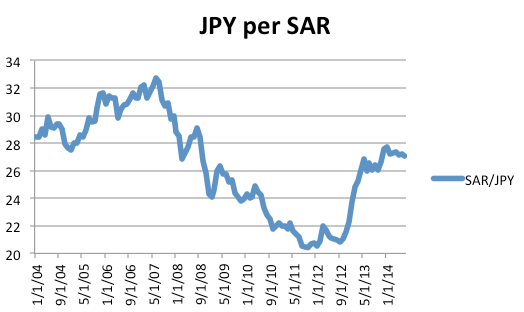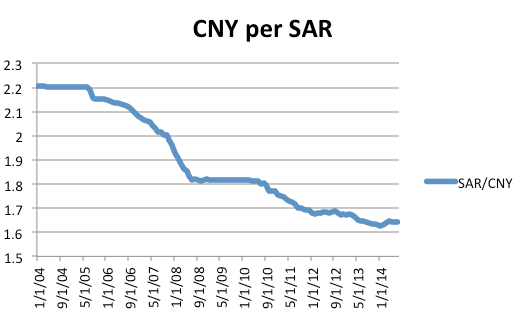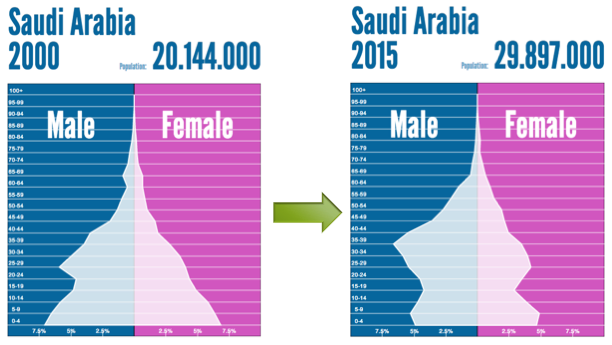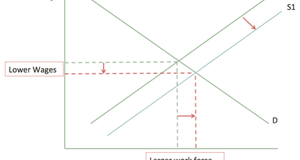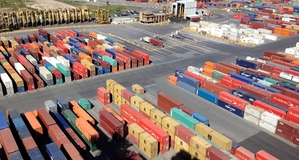The High Cost of Living in Saudi Arabia: Growth and Inflation in a Macroeconomic Perspective
By
2014, Vol. 6 No. 09 | pg. 2/2 | « Inflation in Saudi ArabiaAfter examining Saudi Arabia’s macroeconomic outlook, we will now try to understand the inflation problem. Consumer Price Index (CPI)Examining the CPI index, we find that general index figures can be misleading and do not explain why people are complaining of higher prices in Saudi Arabia. But when we look closely at the groups in Table 3 we find that Housing, Water, Electricity, Gas & Other Fuels are almost double the General Index. Furthermore, when looking at a subgroup under housing, the rent section, we find that it was increasing at almost three times the General Index rate. The same goes for fresh vegetables (9.6%, 2005-2012) a subgroup of the food group (6.3%, 2005-2012)(SAMA, 2014).
Supply SideWe can study the causes of inflation in many different ways. One valid method for Saudi Arabia is examining the supply side of inflation. Are wages and raw materials increasing? Is this having a cost-push effect on prices? Labor Force and WagesTo solve the unemployment issue in Saudi Arabia, the Ministry of Labor has implemented several programs that have helped to reduce unemployment and in turn to push salaries up. The first intervention was Nitaqat, introduced in June of 2011 by the new Minister of Labor. Nitaqat mandated a certain percentage of Saudi workers (vs. non-Saudi workers) in the private sector. This caused a high demand for Saudis overnight, and companies had to pay higher wages to attract them. The second intervention was the minimum wage ordered by King Abdullah in September of 2012, which made the minimum wage $800 per month for any Saudi working in the public sector. The private sector followed suit because of the regulation in the public sector. The third, and most drastic, intervention was the deportation law that caused 20% of foreign labor to leave the country. This supply shock caused the wages of the remaining workers to go up, adding to the problem of wages(Alhamad, 2014). Finally, in the short term, new Saudis that entered the labor force due to these interventions were less trained and experienced, but were higher paid, making them less productive overall. Raw MaterialsIncreasing prices for raw material is an important cause of inflation for most nations, and even more so for Saudi Arabia because it is the main source of income for the country. As in other countries, energy is vital for the life of the people. Table 4 shows the price of Saudi crude oil and the percent of change over the past decade. From this we find that, on average across all oil grades, the annual increase was 17.1%. We also see that in 2010-2011 the increase was very high: 25.9% and 38.2%, respectively. This could be a main cause of the high figures for inflation in the same years: 5.1% and 5.8%, respectively (SAMA, 2014).
CurrencyDepreciation of a country’s currency is a cause of inflation because it becomes more expensive to import products from other parts of the world. In the Saudi case, for example, the depreciation of Saudi currency against the Japanese yen from mid-2007 to the end of 2012 meant that Saudis needed more riyals to buy Japanese products. Because Saudi Arabia imports many products from Japan, this has added to the inflation problem. Figure 9 While the Chinese Renminbi (RMB) has appreciated in value over the past decade, Saudi Arabia imported more goods from China than from any other country aside from the US. Moreover, if you subtract weapons and defense imports, China is the country Saudi Arabia imports most from. This increase in the value of the yuan will surely affect prices in Saudi Arabia from a supply point of view. Figure 10 Demand Side: GDP GrowthLooking at the demographics of Saudi Arabia, we find that the population is clustered more than ever in the age group between 20 and 50, which is considered the most productive time of a person’s life. This is clear when looking at the population pyramid from the year 2000 (see figure 11), where the Saudi population was clustered more under the age of 20. Compare this with the 2015 pyramid, where more people are clustered between 20 and 50. This is a sign of urbanization and that families in Saudi Arabia are getting smaller. This boosts the demand for smaller affordable housing units. This structural shift in population creates new demand that the economy needs to build capacity for, and in the short term must create inflation. This is what is happening today in Saudi Arabia(De Wulf, 2012). Figure 11 Government GrantsHafiz is a program in which people who are looking for work get a monthly allowance until they find a job. More than a million people have participated in the program; this puts money in their hands and creates demand for goods in the economy. Two other programs that were supported in past years were the Housing Authority, which gives houses to lower income citizens, and the Saudi Real Estate Development Fund (FEDF), which grants Saudis interest-free loans to build houses. Many people benefited from these government programs, which created demand in the market for all goods. ConclusionThe issue of inflation in Saudi Arabia is highly complex with is no single root cause, but rather, a group of key factors. Inflation in Saudi Arabia is not apparent when looking at the general figures of the CPI index. The problem arises when examining the groups and subgroups that affect people’s lives, such as food, rent, and housing in general. We find that the general index is much lower than some of the important groups, such as housing, and subgroups, such as rent, which make up a bigger part of an individual’s income. Another interesting issue is that the CPI index for Saudi Arabia seems to be inconsistent with the GDP Deflator that is much higher, even in the long run, which is not the case in most developed economies. Finally, we believe that the CPI index used by Saudi Arabia should be revised to reflect the true increase of the cost of living. This could be an area of research that would greatly help the government and other institutions to better deal with the inflation problem. Appendix
ReferencesIMF. (2013, 7). Saudi Arabia 2013 Article 4 Consultation. Retrieved 8 6, 2014, from http://www.imf.org/external/pubs/ft/scr/2013/cr13229.pdf Looney, R. E. (1990). Infrastucture investment and inflation in Saudi Arabia. Retrieved 08 25, 2014, from http://www.relooney.info/RelJED_1.pdf Rosser, B. (1983). Infrastructure Investment and Inflation in Saudi Arabia. Economic Forum. SAMA. (2014, 6 12). Annual Report. Retrieved 8 4, 2014, from Saudi Arabian Monetary Agency: http://www.sama.gov.sa/sites/samaen/ReportsStatistics/Pages/AnnualReport.aspx Saudi Gazette. (2014, 06 08). Salaries ‘not consistently keeping pace’ with rising cost of living in Saudi Arabia. Retrieved 8 25, 2014, from http://www.saudigazette.com.sa/index.cfm?method=home.regcon&contentid=20140609207817 World Bank. (2014). World DataBank. Retrieved 8 6, 2014, from World Development Indicators: http://databank.worldbank.org/data/views/reports/tableview.aspx# Wulf, M. D. (2012). Saudi Arabia Population Pyramid 2000/2015. Retrieved 08 20, 2014, from Population Pyramids of the World from 1950-2100: http://populationpyramid.net/saudi-arabia/2000/
Suggested Reading from Inquiries Journal
Inquiries Journal provides undergraduate and graduate students around the world a platform for the wide dissemination of academic work over a range of core disciplines. Representing the work of students from hundreds of institutions around the globe, Inquiries Journal's large database of academic articles is completely free. Learn more | Blog | Submit Latest in Economics | ||||||||||||||||||||||||||||||||||||||||||||||||||||||||||||||||||||||||||||||||||||||||||||||||||||||||||||||||||||||||||||||||||||||||||||||||||||||||||||||||||||||||||||||||||||||||

